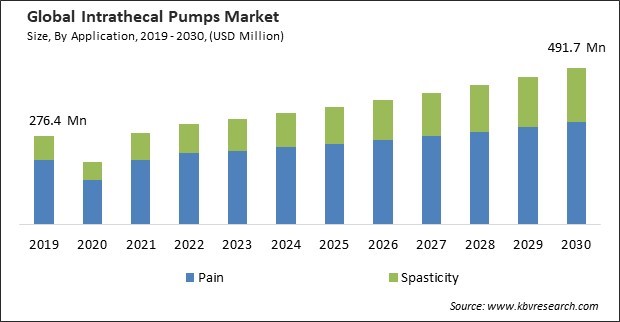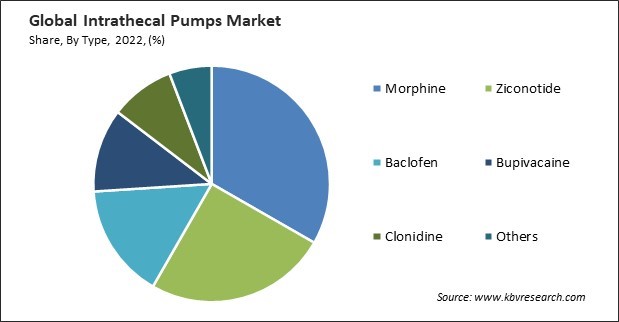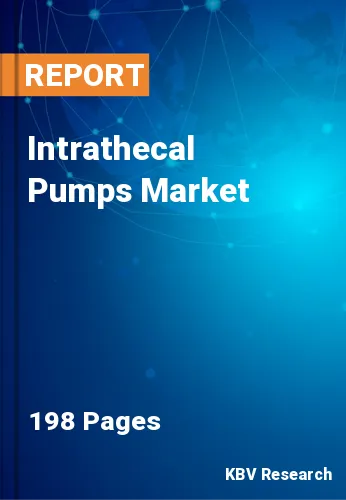The Global Market size is expected to reach $491.7 million by 2030, rising at a market growth of 5.7% CAGR during the forecast period.
Bupivacaine is regarded as an exceptional adjunctive drug in intrathecal therapy. Thus, the Bupivacaine segment acquired $36,149.5 thousand in 2022. The synergistic enhancement of intrathecal opioid effects when bupivacaine is combined with them has been demonstrated in multiple studies, which has contributed significantly to its expanding market share. Bupivacaine reduces dose escalations of intrathecal opioids and permits some patients to reduce their oral opioid utilization. Thus, it is envisaged that several benefits associated with bupivacaine will sustain segment expansion. Some of the factors impacting the market are technological advancements in pump design, expanding applications in pain management and neurological disorders, and high initial costs and economic considerations.

Modern intrathecal pumps have advanced mechanisms that enable precise and accurate drug delivery. This precision is crucial for administering the proper medication dosage directly to the spinal cord, optimizing therapeutic effects while minimizing the risk of side effects. The integration of smart pump technologies has enhanced the capabilities of intrathecal pumps. These technologies often include remote monitoring, connectivity, and data analytics features. Healthcare providers can remotely monitor patient data, receive real-time alerts, and adjust the pump settings, improving overall patient care and management. Additionally, intrathecal pumps were initially developed for pain management, but their successful application has expanded to address a variety of neurological disorders, including spasticity, dystonia, and severe cases of Parkinson's disease. This diversification broadens the potential patient population benefitting from intrathecal pump therapy. Using these pumps in neurological disorders improves functionality and mobility in affected individuals. By directly targeting the underlying neurological mechanisms, these pumps help reduce muscle spasticity, dystonia, and other symptoms that can enormously impact a person's ability to move and perform daily activities. Healthcare teams comprising pain specialists, neurologists, and other relevant specialists collaborate to develop comprehensive treatment plans that address pain and associated neurological symptoms. Thus, the above-mentioned factors will expand the market growth.
Further, the COVID-19 pandemic moderately impacted the market. Many elective surgeries and medical procedures, including those related to intrathecal pump implantation, were postponed, or canceled during the initial phases of the pandemic. Hospitals and healthcare facilities were under immense pressure to prioritize COVID-19 cases, leading to delays in non-urgent procedures. This delay had influenced the market's growth trajectory, as patients defer elective surgeries, affecting both new installations and replacements. The global disruptions in supply chains caused by the pandemic have affected the availability of medical devices and components. Manufacturers of these pumps and related accessories faced challenges in procuring raw materials, production delays, and logistical issues. These disruptions contributed to fluctuations in the market, affecting both the supply and demand sides. As a result, due to these changes, the market is expected to grow significantly in the coming years.
However, the substantial upfront costs associated with intrathecal pump therapy, including the cost of the pump, surgical implantation, and related procedures, can create financial barriers to access. Patients without adequate insurance coverage or financial resources may face challenges accessing this advanced treatment option. Inconsistent or inadequate reimbursement policies can hinder the widespread adoption of intrathecal pump therapy. The lack of reimbursement or reimbursement rates that do not adequately cover the costs associated with the therapy may discourage healthcare providers from offering it as a treatment option. The financial burden on patients could lead to decreased patient adherence, reluctance to pursue intrathecal pump therapy or potential treatment discontinuation. Due to the above aspects, market growth is expected to decline in the coming years.
On the basis of type, the market is segmented into baclofen, bupivacaine, clonidine, morphine, ziconotide, and others. In 2022, the morphine segment dominated the market with the maximum revenue share. Morphine is the benchmark for intrathecal drug delivery due to its robust affinity for receptors, consistent performance, and substantial body of user knowledge. Furthermore, morphine has been granted sanction by the US FDA for the treatment of long-term intrathecal pain. Furthermore, compared to systemic opioids, long-term intrathecal morphine has fewer adverse effects, which is anticipated to stimulate the growth of this market segment. Owing to their ability to alleviate discomfort, opioids like morphine are frequently prescribed, per the WHO. They efficiently alleviate a wide range of pain, encompassing both acute and chronic ailments. Pain signals are diminished through the action of these medications on specific receptors in the brain and spinal cord.

Based on application, the market is fragmented into spasticity and pain. The spasticity segment garnered a significant revenue share in the market in 2022. It delivers medications, such as baclofen, directly to the spinal cord. Baclofen is a muscle relaxant that operates on the central nervous system to reduce spasticity. The targeted delivery allows for a more adequate concentration of the drug at its site of action, leading to better control of muscle tone and spasticity. Controlling spasticity through intrathecal pump therapy can improve muscle function and range of motion. This allows individuals to engage in physical therapy and rehabilitation more effectively, improving overall mobility and functionality.
| Report Attribute | Details |
|---|---|
| Market size value in 2022 | USD 316.8 Million |
| Market size forecast in 2030 | USD 491.7 Million |
| Base Year | 2022 |
| Historical Period | 2019 to 2021 |
| Forecast Period | 2023 to 2030 |
| Revenue Growth Rate | CAGR of 5.7% from 2023 to 2030 |
| Number of Pages | 198 |
| Number of Table | 280 |
| Report coverage | Market Trends, Revenue Estimation and Forecast, Segmentation Analysis, Regional and Country Breakdown, Porter’s 5 Forces Analysis, Company Profiling, Companies Strategic Developments, SWOT Analysis, Winning Imperatives |
| Segments covered | Type, Application, Region |
| Country scope |
|
| Companies Included | Medtronic plc, ICU Medical, Inc. (Smiths Medical), Teleflex, Inc., Johnson & Johnson (Johnson & Johnson Services, Inc.), Baxter International, Inc., Abbott Laboratories, Tricumed Medizintechnik GmbH, Flowonix Medical, Inc., Durect Corporation, and Novartis AG |
| Growth Drivers |
|
| Restraints |
|
Region-wise, the market is analyzed across North America, Europe, Asia Pacific, and LAMEA. In 2022, the North America region registered the highest revenue share in the market. The presence of adequately equipped primary, secondary, and tertiary care facilities bolstered growth in the North American market. In addition, favorable government funding and a robust reimbursement network are anticipated to drive market expansion. Expected to stimulate demand for intrathecal pumps in this region are the increasing collaborative efforts of key market participants to enhance their product lines and guarantee superior quality. An increased demand for sophisticated and effective intrathecal pumps is a result of the escalating incidence of cancer in the United States.
Free Valuable Insights: The Global Intrathecal Pumps Market size to reach USD 491.7 Million by 2030
The market research report covers the analysis of key stake holders of the market. Key companies profiled in the report include Medtronic plc, ICU Medical, Inc. (Smiths Medical), Teleflex, Inc., Johnson & Johnson (Johnson & Johnson Services, Inc.), Baxter International, Inc., Abbott Laboratories, Tricumed Medizintechnik GmbH, Flowonix Medical, Inc., Durect Corporation, and Novartis AG
By Application
By Type
By Geography
This Market size is expected to reach $491.7 million by 2030.
Technological advancements in pump design are driving the Market in coming years, however, High initial costs and economic considerations restraints the growth of the Market.
Medtronic plc, ICU Medical, Inc. (Smiths Medical), Teleflex, Inc., Johnson & Johnson (Johnson & Johnson Services, Inc.), Baxter International, Inc., Abbott Laboratories, Tricumed Medizintechnik GmbH, Flowonix Medical, Inc., Durect Corporation, and Novartis AG
The expected CAGR of this Market is 5.7% from 2023 to 2030.
The Passenger Cars segment is leading the Market, By Vehicle Type in 2022; thereby, achieving a market value of $10.9 billion by 2030.
The Asia Pacific region dominated the Market, By Region in 2022, and would continue to be a dominant market till 2030; thereby, achieving a market value of $6.2 billion by 2030.
Our team of dedicated experts can provide you with attractive expansion opportunities for your business.

